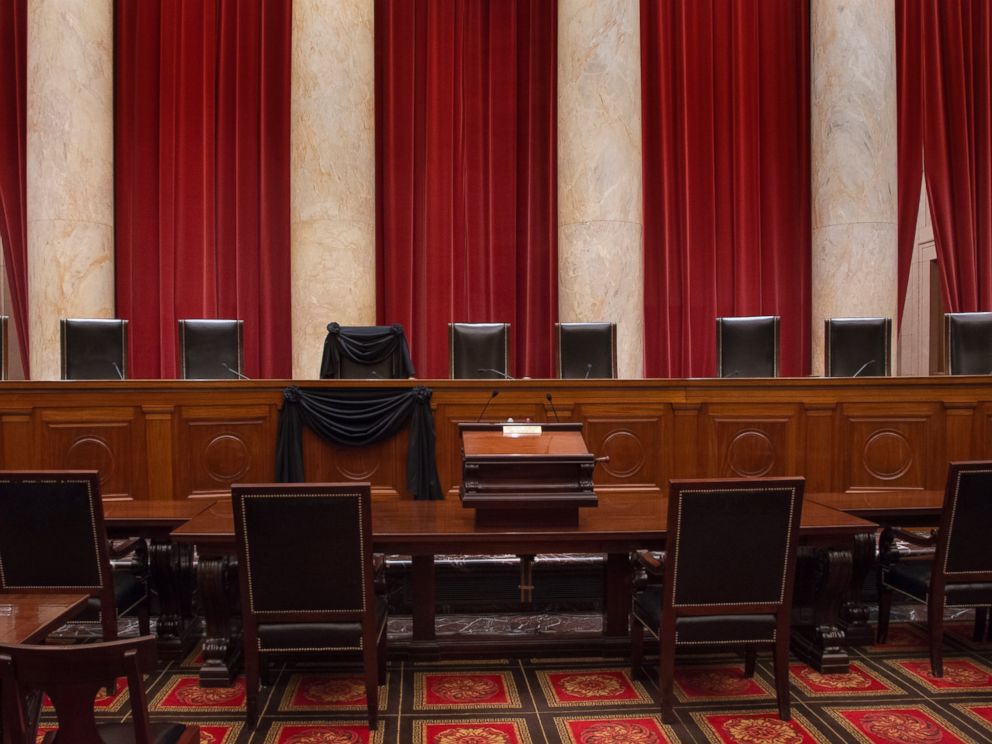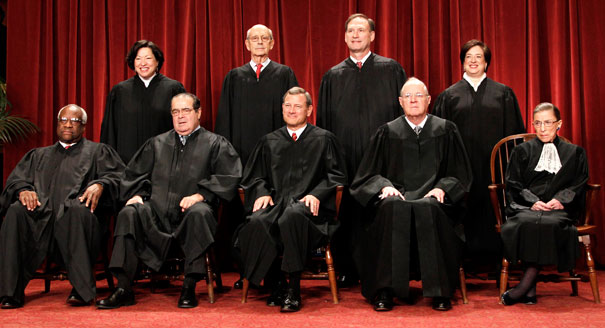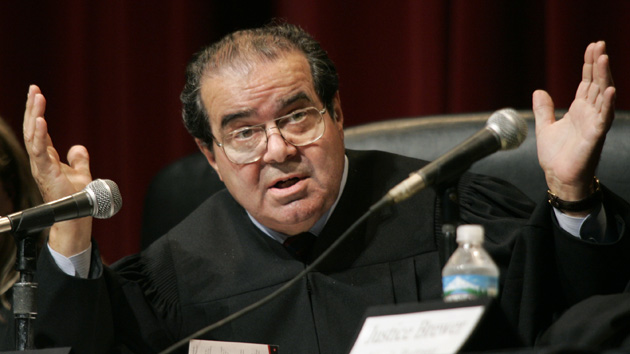The death of Justice Antonin Scalia has sent shockwaves through the political world. Partisans on both sides of the aisle are gearing up for a battle over who will replace one of the court’s most colorful and conservative justices. Senate Majority Leader Mitch McConnell says he will not allow the Senate to vote on a nominee until after the 2016 presidential election. President Obama has met his challenge, saying that he will put forth a nominee and force the Senate Republicans to either give them a hearing or reveal their blatant partisanship. More interesting than the upcoming nomination battle though is the effect that Scalia’s death will have on the court’s guiding ideology. Without Scalia, the court’s conservatives are sorely lacking. In fact, his passing will likely start the court on a leftward sprint with no end in sight.
In a legal system based on tradition, it only seems fitting that the Supreme Court has been the standard-bearer of conservatism during the Obama presidency. With Congress hopelessly gridlocked, the executive and judicial branches have been front and center in the country’s ideological struggle. Make no mistake, this is the most conservative court since before the New Deal. This is the court that opened the floodgates for unlimited campaign spending in Citizens United v. FEC and stuck down parts of the 1965 Voting Rights Act in Shelby County v. Holder. Liberal decisions that twice upheld the Affordable Care Act and made same-sex marriage a fundamental right are exceptions, not the rule. Even though he was lambasted by Republican presidential candidates for writing both majority opinions upholding the Affordable Care Act, Chief Justice John Roberts is one of the five most conservative justices since 1937. Three other justices, Clarence Thomas, Samuel Alito, and Scalia, are also among the top five, with Thomas being the most conservative ever. Even Anthony Kennedy, the court’s swing vote, is in the top 10.
The court is highly polarized, with vast ideological differences between Kennedy (the most liberal member of the court’s five conservatives) and the four liberal justices. The combination of a sharp philosophical divide and the slim conservative majority makes the court susceptible to wild swings in its ideological bent. Its recent bout of conservativism began when Alito replaced the moderate Sandra Day O’Connor in 2006. Justice O’Connor was the swing vote, casting decisive votes that upheld affirmative action in higher education and the right to have an abortion. Without her, the decidedly more conservative Kennedy became the court’s center and shifted its decisions firmly to the right. This thin ideological balance has not escaped the notice of the justices. They have strategically planned their departures to ensure that the balance continues to favor their ideology. O’Connor, a Republican appointee, only decided to retire when a Republican president could replace her. Similarly, liberals David Souter and John Paul Stevens waited until Obama took over from George W. Bush to step aside. Scalia was likely waiting until after 2016 to retire, keeping his fingers crossed that the country rejected a third term under a Democratic president.
With Scalia’s unexpected death, the conservative justices now find themselves on the wrong side of the ideological swing they have been enjoying since Alito’s appointment. There is now an even split between conservatives and liberals. When the justices split 4-4, the decision of the appellate or district court that heard the case before the Supreme Court is upheld. Unfortunately for conservatives, major decisions will be out of their hands if the court’s liberals stick together and force a split decision.
“Throughout the Obama era, the conservative response to Obama’s executive actions has often come through the courts.”
In Friedrichs v. California Teachers Association, the court will look at the mandatory fees that public sector unions charge to all public employees. The challenge is being made under First Amendment grounds, namely that public employees should have a choice as to whether or not they subsidize a union’s political speech. This would normally be a slam dunk case for the conservatives. Oral arguments made clear that Justice Kennedy agreed with the steady four conservatives in their opposition to forced political speech. However, the lower court ruled in favor of the unions, and with Scalia gone, their ruling will stand.
Harris v. Arizona Independent Redistricting Commission and Zubik v. Burwell present similar situations. In Harris, the lower court upheld Arizona’s plan to draw congressional districts using an independent commission rather than the Republican-controlled state legislature. In Zubik, lower courts refused to further diminish the mandate that businesses provide contraceptives to females that the conservatives weakened in Burwell v. Hobby Lobby. Scalia’s vote would have been crucial in striking down both of these decisions.
A split court will do more than just swing a few cases in favor of the liberals. Throughout the Obama era, the conservative response to Obama’s executive actions has often come through the courts. The pattern goes something like this: Obama acts unilaterally to advance a liberal cause. A deadlocked Congress is unable to respond. The Supreme Court is expected to block Obama’s actions. Examples include the court striking down the Department of Health and Human Services’ contraceptive mandate in Hobby Lobby and their disavowal of Obama appointing officials without the Senate’s consent in National Relations Labor Board v. Noel Canning. Without a functioning legislative branch, the Supreme Court has been one of the only ways for Republicans to fight back against Obama and the rising tide of liberalism.
Scalia’s death will throw the liberal president/conservative court balance off kilter in favor of the president. Take the Clean Power Plan challenge. This EPA regulation significantly curbs the carbon emissions that states can allow. It was the United States’ major bargaining chip at the international climate talks in Paris last December. Just days before Scalia died, the conservative justices agreed to delay enforcement of the rule until it was heard by the Court of Appeals for the DC Circuit and, eventually, the Supreme Court itself. With Scalia, it looked to be another Supreme Court victory over Obama. But now that he has passed on, the DC Circuit Court will likely have the final say over the Clean Power Plan. The three judge panel that will hear the case leans to the left. Judges Judith Rogers and Karen Henderson have both supported environmental causes in the past. The third judge, Sri Srinivasan, is an Obama appointee and has been mentioned as one of the top choices for the president to nominate to the Supreme Court before the end of 2016. If the DC Circuit upholds the plan and the Supreme Court reviews it (only four justices need to agree to hear a case), then there will probably be a split decision that leaves the rule in place. Just like that, the conservative’s judicial advantage in environmental policy is gone.
Chief Justice Roberts could use his sway to keep controversial cases like the Clean Power Plan off the court’s agenda until after the 2016 election. He would be betting that the conservative majority will be restored by the next president and that the major issues, and the potential to create sweeping national precedent, will be decided by that majority. If he is wrong, these controversies will be decided by a liberal majority. If the last six presidential elections provide any direction, the Democrats will win in 2016. They have won the same 18 states (plus Washington, D.C.) in each of the last six elections. This “blue wall” gives the Democrats 242 electoral votes right off the bat. They only need to win Florida or a simple combination of swing states to win the presidency. Republicans, on the other hand, must win nearly every swing state to capture the presidency. Changing demographics and the quality of 2016 presidential candidates also favor the Democrats. Barring an FBI indictment, it is likely that Hillary Clinton will appoint Scalia’s successor. Ginsburg, Kennedy, and Breyer would all be in their 80s if Clinton wins two terms. If she replaces them all with liberal leaning justices, it will cement the court’s leftward lunge.
Without Scalia, the first conservative majority in seven decades is facing its doom. Unless Republicans shape up in the 2016 election, Roberts, Alito, Kennedy, and Thomas will largely be relegated to minority opinions. Without control of the Supreme Court, Republicans will have to advance conservative policies through Congress. Crippling gridlock and a membership fractured by the insurgent Tea Party make that highly unlikely.
Perhaps losing control of the Supreme Court will be a good thing for Republicans. It might force them to adapt to a changing electoral environment. In many ways, a conservative Supreme Court has been a crutch for Republicans because it allowed them to avoid compromise on major issues. Without Scalia, they will no longer be able to rely on court decisions to implement their conservative policies. Instead, they will have to advance pragmatic public policy that can hold support from both sides of the aisle.
Justice Scalia was without a doubt a brilliant man who believed deeply in his principles. His opinions were clever, insightful, and, according to his friend Justice Ginsburg, forced liberals to prepare for harsh objection and vigorous debate. He was relic of the past though. The country is moving to the left and the court is going with it. Unless conservatives adjust their ideology to a changing America, they will find themselves in the same position as the remaining conservative justices after Scalia’s replacement is named—bitterly dissenting from a small and shrinking minority position.


